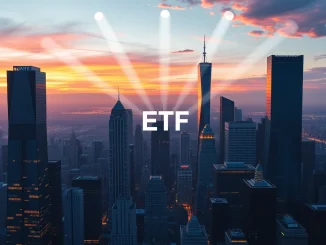
Are you keeping an eye on the pulse of the digital asset market? If so, you’ve likely noticed the impressive momentum building around Spot Bitcoin ETFs. These investment vehicles have become a hot topic, drawing significant capital and reflecting a growing mainstream interest in Bitcoin. On July 15, the U.S. Spot Bitcoin ETF market experienced another remarkable day, recording a substantial $404.85 million in net inflows. This marked the ninth consecutive day of positive flows, signaling a robust and sustained appetite among investors for regulated Bitcoin exposure.
Understanding the Latest Bitcoin ETF Inflows
The consistent positive Bitcoin ETF inflows are a powerful indicator of shifting investor sentiment. For nine straight days, more money has poured into these funds than has exited, painting a picture of increasing confidence in Bitcoin’s long-term value proposition. This sustained buying pressure can have a significant impact on Bitcoin’s price and overall market dynamics, suggesting that institutional and retail investors alike are actively seeking exposure to the world’s leading cryptocurrency through regulated channels.
Let’s break down the numbers from July 15:
- Total Net Inflows: $404.85 million
- Streak: Ninth consecutive day of positive flows
This steady accumulation through ETFs highlights their growing importance as a gateway for traditional finance into the crypto space. It’s not just a one-off event; it’s a trend that’s been building momentum, showing that investors are increasingly comfortable with Bitcoin as a legitimate asset class.
Which US Bitcoin ETFs Are Leading the Charge?
While the overall picture is one of strong inflows, a closer look reveals that not all US Bitcoin ETFs are performing equally. On July 15, certain funds stood out for their significant contributions to the net positive figure, while others saw outflows. This differentiation is crucial for understanding investor preferences and the competitive landscape of the Bitcoin ETF market.
Here’s a snapshot of the top performers and those experiencing outflows:
| ETF Ticker | Manager | Net Flow (July 15) |
|---|---|---|
| IBIT | BlackRock | +$418.20 million |
| HODL | VanEck | +$18.99 million |
| Mini BTC | Grayscale | +$18.56 million |
| BITB | Bitwise | +$12.70 million |
| EZBC | Franklin Templeton | +$6.76 million |
| GBTC | Grayscale | -$41.22 million |
| FBTC | Fidelity | -$22.93 million |
| ARKB | ARK Invest | -$6.21 million |
As you can see, BlackRock’s IBIT continues to be a dominant force, single-handedly contributing more than the total net inflow, which means other funds experienced outflows. This highlights a clear preference among investors for certain providers and products, possibly due to factors like liquidity, fees, or brand recognition.
BlackRock IBIT: A Juggernaut in the ETF Space
It’s impossible to discuss the recent BlackRock IBIT performance without acknowledging its incredible run. On July 15, IBIT alone brought in a staggering $418.20 million. This consistent outperformance positions BlackRock’s Spot Bitcoin ETF as a leading choice for investors looking to gain exposure to Bitcoin. Their massive inflows often offset outflows from other funds, keeping the overall market in positive territory.
What makes IBIT so attractive? Several factors could be at play:
- Brand Trust: BlackRock is one of the world’s largest and most respected asset managers.
- Liquidity: High trading volumes indicate strong liquidity, making it easier for large investors to enter and exit positions.
- Marketing and Distribution: BlackRock’s extensive network likely plays a role in reaching a broad investor base.
The continued success of IBIT underscores the significant institutional interest that a trusted name can command in the burgeoning crypto investment landscape.
What Do These Crypto Investment Trends Mean for the Future?
The consistent positive flows into crypto investment trends, particularly via Spot Bitcoin ETFs, paint a compelling picture for the future of digital assets. These trends suggest a maturing market where Bitcoin is increasingly viewed as a legitimate, accessible asset for diversified portfolios. The sustained demand indicates that investors are moving beyond speculative interest and embracing Bitcoin as a long-term store of value or a strategic investment.
Key takeaways from these trends:
- Mainstream Adoption: ETFs are bridging the gap between traditional finance and crypto, making Bitcoin more accessible to a wider audience.
- Institutional Confidence: Large inflows from major asset managers like BlackRock signal growing institutional confidence in Bitcoin.
- Market Stability: Consistent inflows can contribute to greater market stability and reduce volatility over time, as more ‘sticky’ capital enters the ecosystem.
- Future Products: The success of Bitcoin ETFs could pave the way for other crypto-related ETF products, such as those for Ethereum or other altcoins.
These trends are not just about daily numbers; they reflect a fundamental shift in how the financial world perceives and interacts with cryptocurrency.
Conclusion: A New Era for Bitcoin Investment
The $404.85 million in net inflows into U.S. Spot Bitcoin ETFs on July 15, marking the ninth consecutive day of positive momentum, is more than just a statistic. It’s a powerful affirmation of Bitcoin’s growing acceptance within mainstream finance. Led by BlackRock’s formidable IBIT, these inflows demonstrate a robust and sustained investor appetite for regulated exposure to the world’s premier digital asset. As more traditional investors gain access through these accessible vehicles, the future of Bitcoin investment appears brighter than ever, signaling a new era of integration between digital assets and the broader financial ecosystem. This consistent positive trend suggests a maturing market, where Bitcoin is increasingly recognized for its long-term potential.
Frequently Asked Questions (FAQs)
Q1: What is a Spot Bitcoin ETF?
A Spot Bitcoin ETF (Exchange-Traded Fund) is an investment vehicle that holds actual Bitcoin. Unlike Bitcoin futures ETFs, which track futures contracts, a Spot Bitcoin ETF aims to directly track the price of Bitcoin by holding the underlying asset. This allows investors to gain exposure to Bitcoin’s price movements without directly owning or managing the cryptocurrency themselves.
Q2: Why are consistent net inflows into Bitcoin ETFs significant?
Consistent net inflows indicate strong and sustained investor demand for Bitcoin exposure through regulated channels. This suggests growing confidence from both institutional and retail investors, validates Bitcoin as a legitimate asset class, and can contribute to positive price momentum and market stability over time.
Q3: Which Bitcoin ETF saw the largest inflows on July 15?
On July 15, BlackRock’s IBIT (iShares Bitcoin Trust) led the surge with a significant $418.20 million in net inflows, making it the top performer among all U.S. Spot Bitcoin ETFs for that day.
Q4: Do all Spot Bitcoin ETFs experience positive inflows?
No, as seen on July 15, some Spot Bitcoin ETFs, such as Grayscale’s GBTC, Fidelity’s FBTC, and ARK Invest’s ARKB, recorded net outflows. While the overall market can show net positive flows, individual ETFs may experience varying investor interest, leading to both inflows and outflows.
Q5: How do Bitcoin ETF inflows impact the broader crypto market?
Bitcoin ETF inflows contribute to the overall liquidity and demand for Bitcoin, which can positively influence its price. They also signal increasing mainstream adoption and institutional interest, which can attract more capital into the broader crypto market, potentially benefiting other digital assets as well.



